
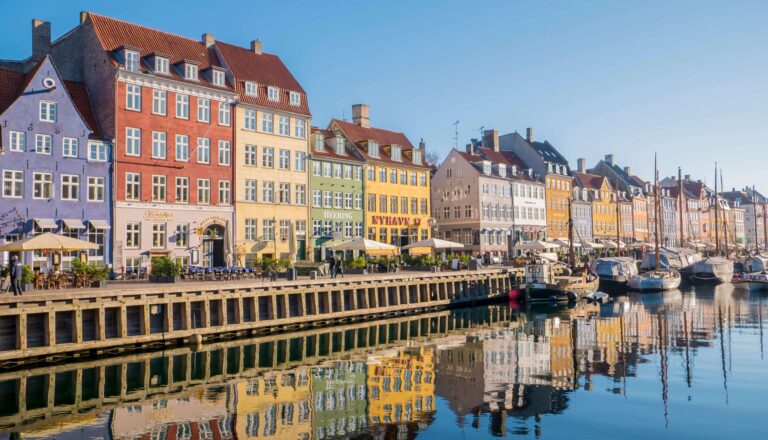
I have made a list of 27 attractions and things to do in Copenhagen to help you plan your visit to the city. Copenhagen is associated with the statue of the Little Mermaid, Tivoli Gardens, Hans Christian Andersen’s fairy tales and the colourful townhouses on Nyhavn. This charming city has many more interesting places to see.
In this guide, you will find a list of things to do, the best tourist attractions and practical tips for exploring Copenhagen. I’ll also give you tips on how to reduce your sightseeing costs, as the Danish capital is not the cheapest city in Europe.
EXPLORE COPENHAGEN CONVENIENTLY
Do you want to save time? Get a map of the most important points of Copenhagen – worth visiting places, monuments, the best cafes, restaurants, museums and recommended accommodation.
Works both on phone & computer (Google Maps).
Having the Copenhagen Card in my pocket encouraged me to see a few places. If I had to pay total ticket prices for admission to attractions, I probably wouldn’t decide to visit some of them.
In the southwest of Copenhagen city center, there is a tourist information desk at the Central Railway Station. You will get city maps and buy a city card there. You can pay with both a card and cash.
What places and attractions are worth seeing with Copenhagen Card?
You can check the available versions of the Copenhagen Card and their prices on the website. You can easily buy the card online.
Where to stay in Copenhagen?
LOW-BUDGET
FEATURES
clean, spacious dormitories
close to public transport
CONVENIENT
FEATURES
high standard
further from the center
close to metro
The Tivoli Gardens is a magical place where Danes forget about their daily duties and play with the whole family.
The amusement park was established in 1843 according to the slogan that “people having fun do not think about politics”. Currently, Tivoli Gardens is one of the largest places of this type in the world and the most popular amusement park in Scandinavia.

One of the first visitors to the park was Hans Christian Andersen. It inspired him to write the fairy tale “The Nightingale”. A year after the park’s opening, a children’s guard and orchestra were formed. Then the activity has become a part of Danish culture.
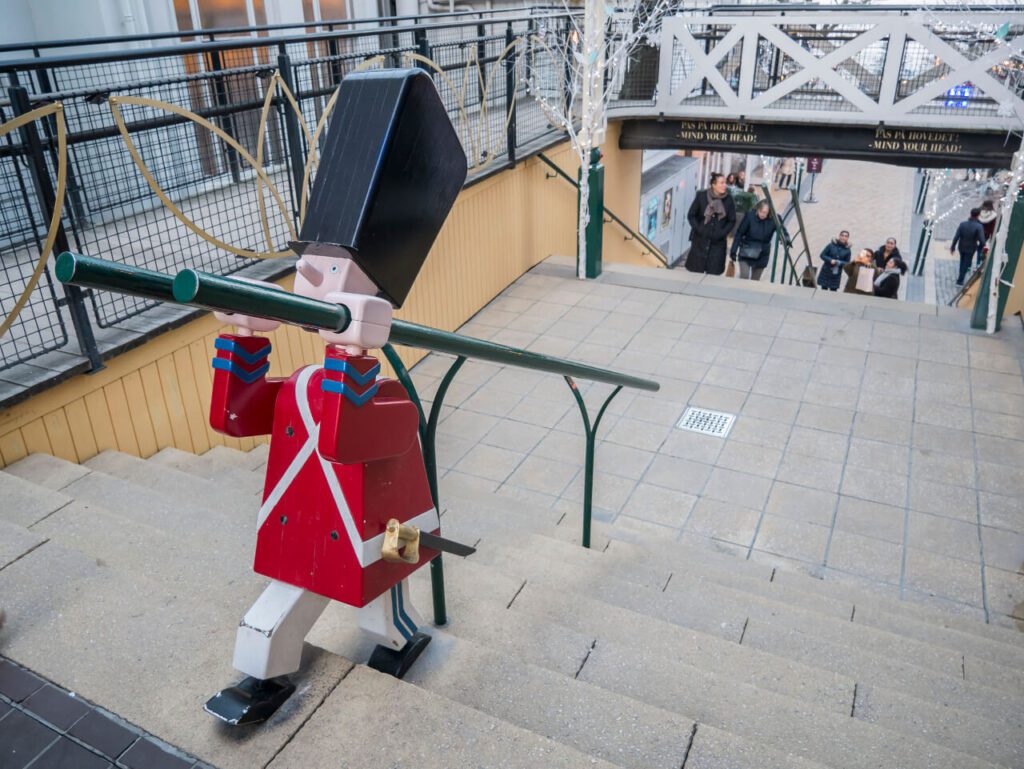
The amusement park operated even during World War II. However, the sabotage of Nazi supporters forced the authorities of Tivoli to temporarily close the park and rebuild it.
In the 1950s, even Walt Disney visited Tivoli Gardens. The attraction made a great impression on him and became an inspiration for Disneyland.

The roller coasters, merry-go-rounds, themed gazebos and gardens, numerous restaurants and cafes are responsible for bringing joy to the visitors. The oriental-looking building in the center of the Tivoli Gardens is Nimb – a luxury hotel with restaurants, operating since 1909.
For those who are brave, I especially recommend the Rutsjebanen roller coaster. It is one of the oldest wooden railways in the world. Its operation has not been automated – it is protected against excessive acceleration by the operator responsible for manual braking.
If you are looking for beautiful views of Copenhagen, you can go to the Himmelskibet (Star Flyer) carousel, which rises to 80 meters.
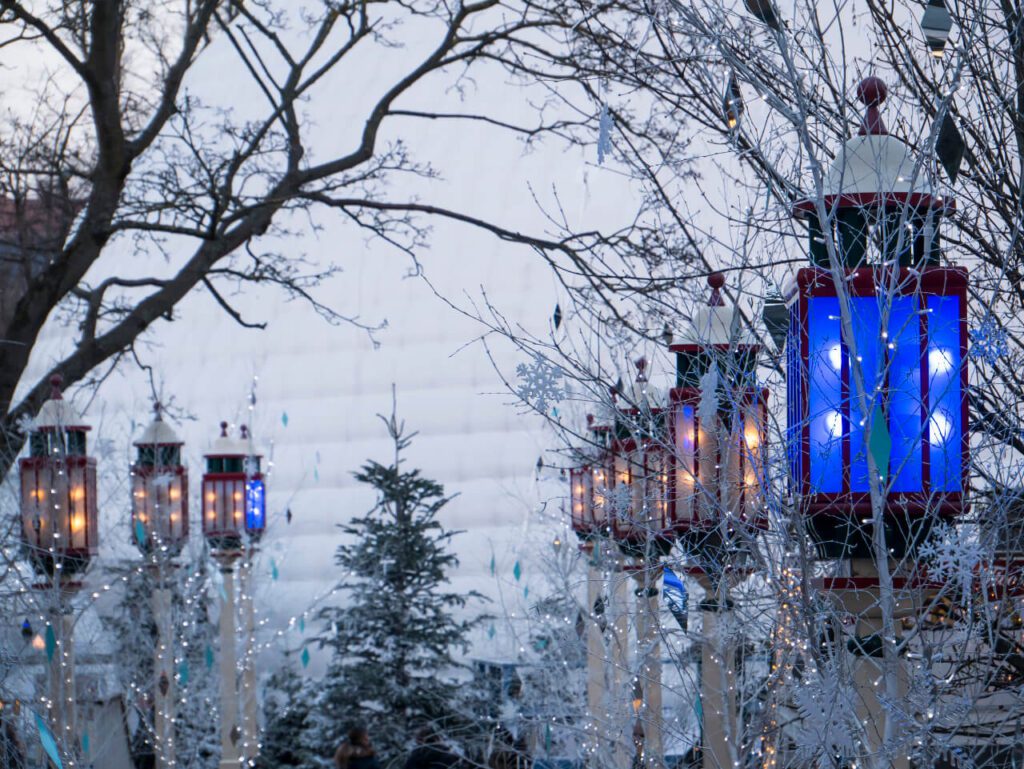
The park is open in summer, Halloween, Christmas and winter. However, it is worth checking the dates on the Tivoli Gardens website in advance. You can find information about current prices and offers on the park’s website.
Copenhagen has experienced the influence of the powerful Jacobsen family in its history, which has turned out to be good for the city.
Jacobsen was a son of the founder of the Carlsberg brewery and a lover and collector of art. In 1882 he decided to open his collection to the people of Copenhagen. So the Glyptotek – a magnificent museum and art gallery located right on the borders of the Tivoli gardens – was established.

The interiors are filled with dozens of marble statues from ancient Greece and Rome, as well as Danish art and French paintings and sculptures. On the walls of Glyptotek, you can see more than 10,000 exhibits.

The idea of bringing this place to life was supported by the desire to create a decent space for the exhibition of Jacobsen’s collections and an oasis in the city center for the facility’s guests. The inner courtyard of Glyptotek is filled with lush plants, creating a beautiful winter garden hidden from the eyes of the street.

The roof of Glyptotek offers an exciting view of Copenhagen. You can spend the sunset here, watching the guests having fun in nearby Tivoli Gardens.



On Tuesdays, the Glyptotek is open to visitors for free, and on Mondays, the museum is completely closed. You will not pay for admission with the Copenhagen Card.
The central, representative place in the capital of Denmark is located on Castle Island and residence of Danish Royal Family. Christiansborg Palace is a baroque building, connected with the mainland by nine bridges.

The modern form of the building complex is at least the fourth incarnation of the building – the previous two went up in flames. The fire in 1794 that consumed Christiansborg Palace forced the royal court to buy Amalienborg Palace and move its permanent residence there quickly.
Christiansborg Palace is the only building in the world to contain all three branches of state power within its walls. The legislative power is represented by the unicameral Folketing Danish parliament, the executive by the prime minister’s office, and the judiciary – by the Supreme Court.
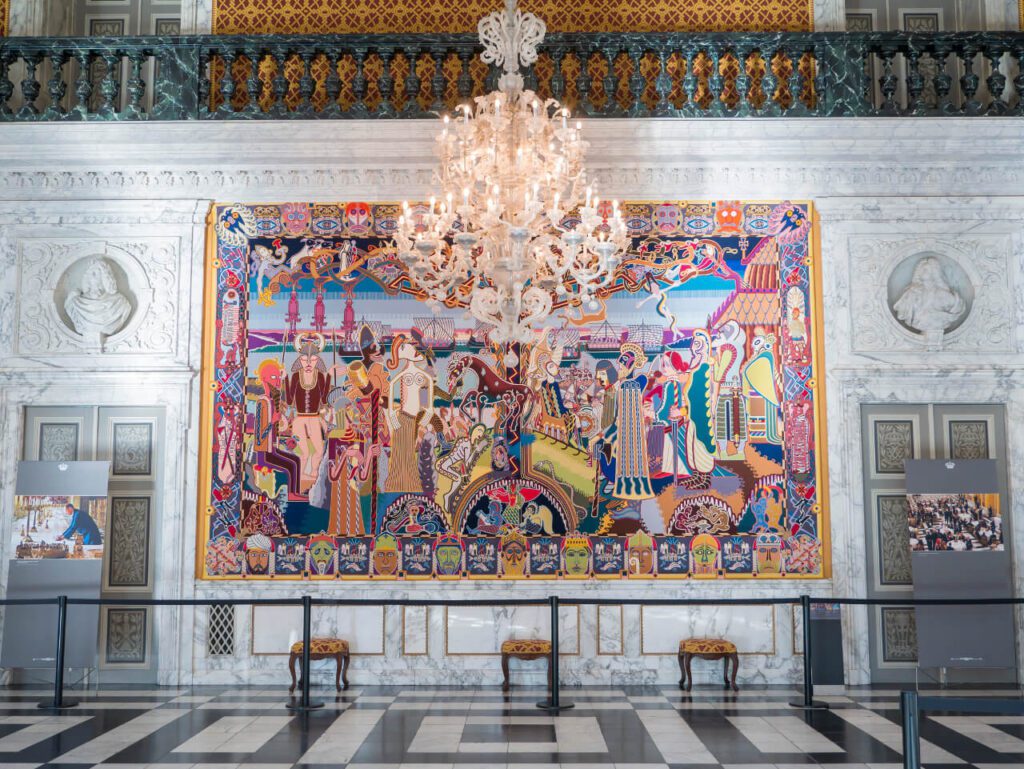
A large part of the complex is open for visitors.
During your visit, pay attention to the tallest tower in Copenhagen (Christiansborg Tårnet), available for free every day except Mondays, and the Royal Reception Rooms used by the Danish crown for representation purposes.
See all available hotels & hostels in Copenhagen
Before entering the tower, you have to go to a security control similar to those at the airport. Part of the distance is covered by an elevator. That’s why you should expect queues.
From the tower, you will be able to see the panorama of Copenhagen. In good weather, it is also possible to notice the buildings of the Swedish city of Malmö on the other side of the Øresund Strait.

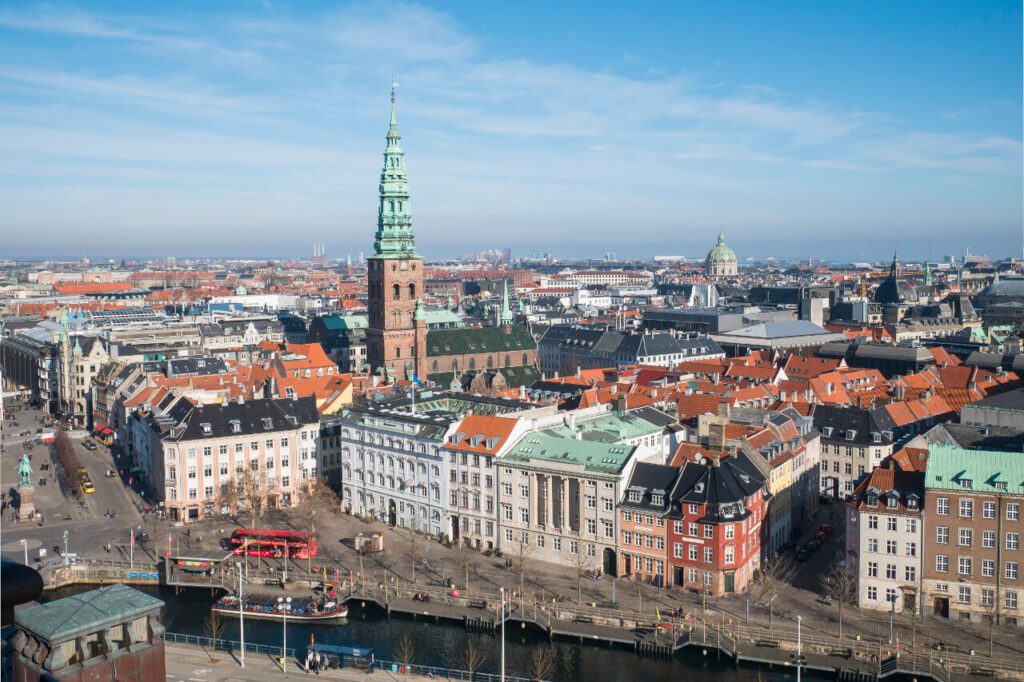
With the Copenhagen Card, entry is free.
The most interesting chambers:
Before entering the royal chambers, you have to put on blue pads to cover your shoes.
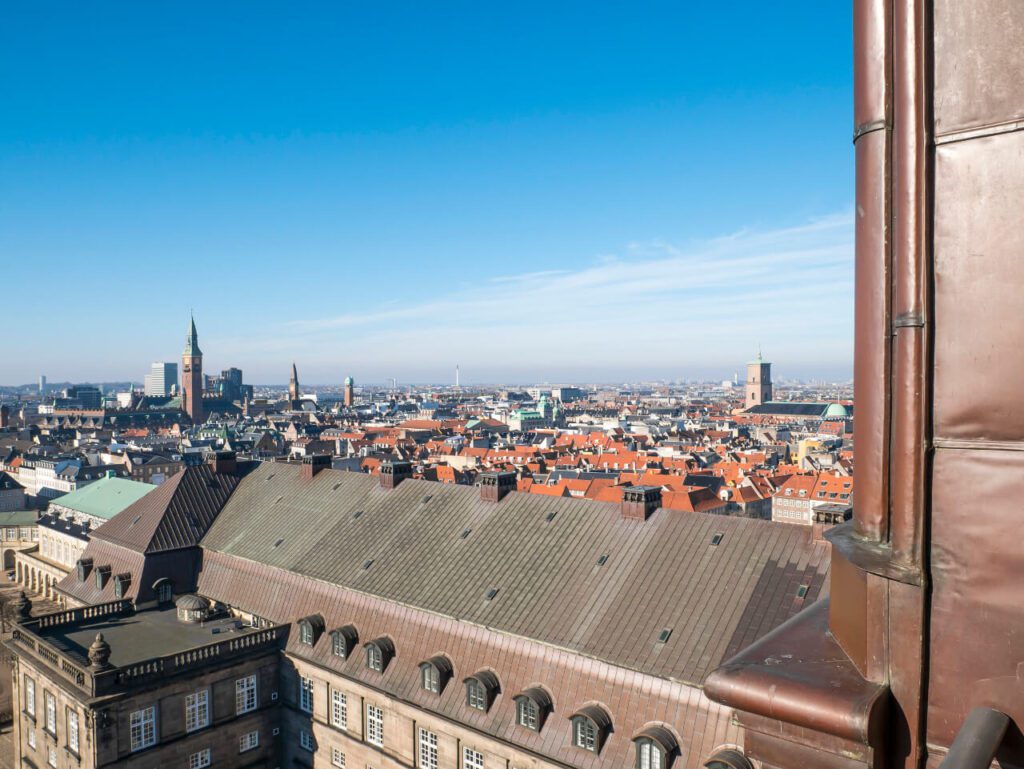

On the night of February 26-27, 1794, the fire consumed the headquarters of the crown Christiansborg Palace. Without it, Amalienborg Palace would have led a much calmer life today.
Within a few days, Christian VII moved with the court to Amalienborg. The complex became the seat of the monarch and royal family in Copenhagen. And he still serves this function.

The complex consists of four identical buildings facing the central part of the square in the shape of a regular octagon. The central point of the square is marked by the statue of Frederick V standing there.
The Danish Queen Margaret II lives in the palace located in the southern part of the square. The heir to the throne, Frederick, occupies the northern one. Unlike the British Buckingham Palace, for example, the close surroundings of Amalienborg are open to pedestrians.
Every day at 12:00 a.m., a ceremonial changing of the guard takes place here, attracting numerous crowds of tourists.
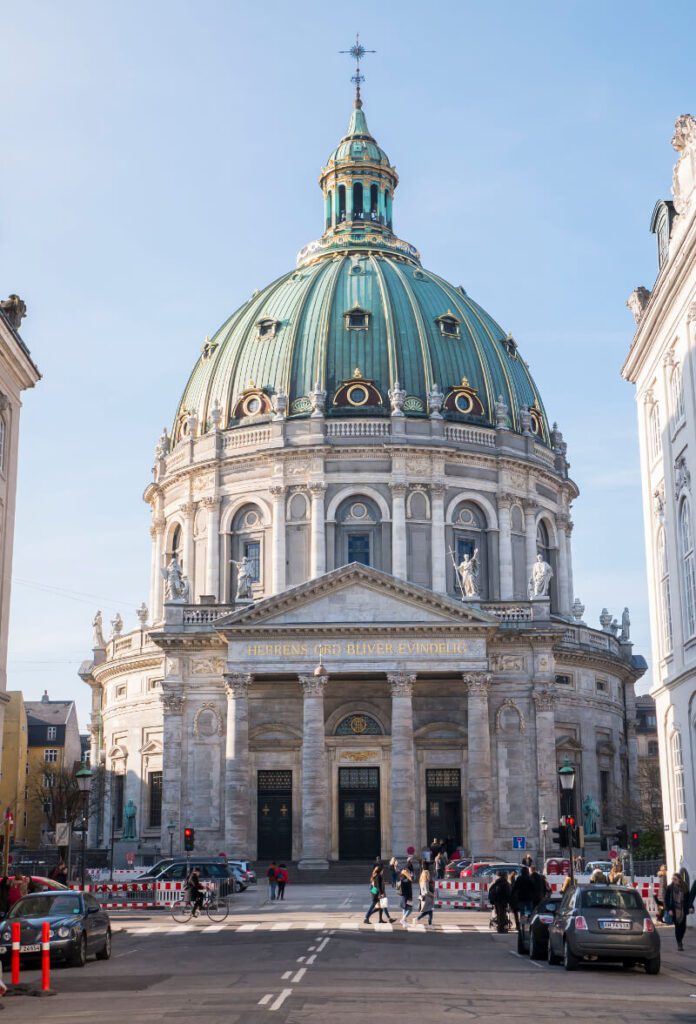
The surroundings of the palaces are guarded around the clock by the Royal Guard. Their massive bearskin hats are reminiscent of those from the British Isles.
The palace museum offers visitors a good dose of knowledge about the everyday life of Danish monarchs. You can see the chambers formerly occupied by kings and royal family members or even a gala hall. The exhibition also explains how the rules governing everyday royal family life have evolved over the years.
You can visit the palace for free with the Copenhagen Card.
Amalienborg Palace is a seat for Margrethe II, Queen of Denmark only during wintertime. Marselisborg Palace or Graasten Palace serves as a summer residence.
EXPLORE COPENHAGEN CONVENIENTLY
Do you want to save time? Get a map of the most important points of Copenhagen – worth visiting places, monuments, the best cafes, restaurants, museums and recommended accommodation.
Works both on phone & computer (Google Maps).
I found Rosenborg Castle, with its magnificent Knights Hall, the most beautiful and interesting architecturally out of Copenhagen’s three main palace complexes.
It was built by order of King Christian IV and intended as a suburban residence. A large park was arranged around the castle, later called the King’s Garden (Kongens Have).



Frederick IV did not share Christian’s enthusiasm, who ruled in 1699-1730 and considered Rosenborg Castle outdated and inconvenient. Frederick’s successors stayed in the palace only on two occasions due to the Christiansborg fire and during the English attack on Copenhagen in 1801.
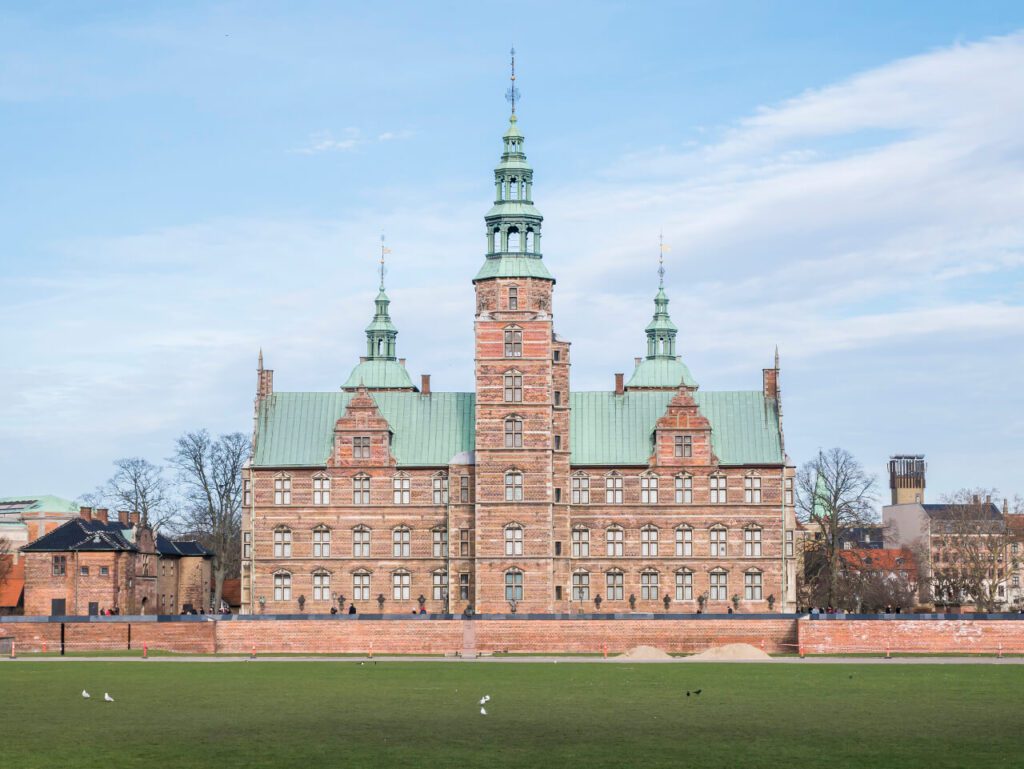


Next to the Rosenborg Palace, there is another exciting attraction – Denmark’s largest Botanical Garden with the Natural History Museum of Denmark. The garden is full of various plants – it has, among others, rock gardens with vegetation from the Alps and other mountain areas.
Rosenborg has been hosting a museum within its walls since 1838. The collection deals with the Danish history of the Oldenburg dynasty. Visitors can see the well-preserved chambers formerly used by the palace inhabitants, the Knight’s Hall with the coronation throne and the real-size statues of three lions.

In the underground treasury of the palace, you can see coronation regalia and Danish crown jewels, including the crown of Christian IV from the 16th century. You will find a detailed description of the interior on the palace website.
Nyhavn is said to be the longest bar in all of Scandinavia – meaning, of course, the tightly packed bars and restaurants that never sleep.
If you know a photo of a row of colourful houses reflecting off the water full of moored ships, you probably got to know Nyhavn before you even got to it. You can also find older, wooden ships in this place.

Nyhavn was built in the 17th century by Swedish prisoners of war as a canal and street of fewer than 500 meters, tightly built up on both sides with tenement houses. The motivation for the construction of the canal was the desire to facilitate the unloading of goods brought to Copenhagen by sea.
Nyhavn, or New Harbour, goes deeper into the city to the height of the Royal Square (Kongens Nytorv). The oldest building by the canal is tenement house number 9. It was built in 1681 and has not been modified from that time. One of the famous Danes, Hans Christian Andersen lived in Nyhavn for many years – in tenement houses number 67, 18 and 20.
Where to stay in Copenhagen?
LOW-BUDGET
FEATURES
clean, spacious dormitories
close to public transport
CONVENIENT
FEATURES
high standard
further from the center
close to metro
In the second half of the twentieth century, the canal became a tourist attraction. After the earlier cessation of commercial ship traffic, it was renovated and became more friendly to visitors. Many tourists came to Nyhavn searching for Hans Christian Andersen’s tenement houses, which helped the area’s development.
When the trade flourished here, this area was by no means a showcase of the city. It attracted tourists and people who wanted to take advantage of the numerous cathouses.

Currently, Nyhavn showcases the city and the most popular theme of postcards from Copenhagen. This is also the place where Copenhagen nightlife thrives as some of the pubs and restaurants operate here around the clock. However, you have to be careful – the prices here are higher than in other, less popular parts of the city.
Cruise ships depart from the marina at the end of the canal, next to the popular mermaid statue. If you have the Copenhagen Card, you can join the canal tour with free entry.
Each participant receives headphones when boarding. You have to plug them into the sockets located next to each seat.


During the cruise, you will pass near the Copenhagen Opera House, the complex of Amalienborg and Christianborg palaces, the Royal Library and the famous Little Mermaid statue.
The sculpture was donated by Carl Jacobsen, the son of the founder of the Carlsberg brewery. The Little Mermaid statue became a symbol of Copenhagen.

Tourists actually occupy the Little Mermaid statue, so seeing it from the water level might be a sensible solution. It will surely protect us from the crowd pushing along the shore.
Near the King’s Garden at Rosenborg Palace, you will find the Round Tower (Rundetaarn). The structure is less than 36 meters long. It was built in the 17th century as a university astronomical observatory, student church and library. The place still serves its first task, which makes it the oldest astronomical observatory in Europe.
Like many significant Copenhagen buildings, Round Tower was by King Christian IV order. A spiral road with no stairs leads to its top, which wraps around the tower’s core exactly 7.5 times.

If you follow the path to the top as close to the center of the tower as possible, it is only 85.5 meters long. If you decide to walk “on the outside”, you will have 268.5 meters in your legs.
From the vantage point you have a nice view of the center of old Copenhagen. You will have a full panorama, because the terrace can be easily walked around.
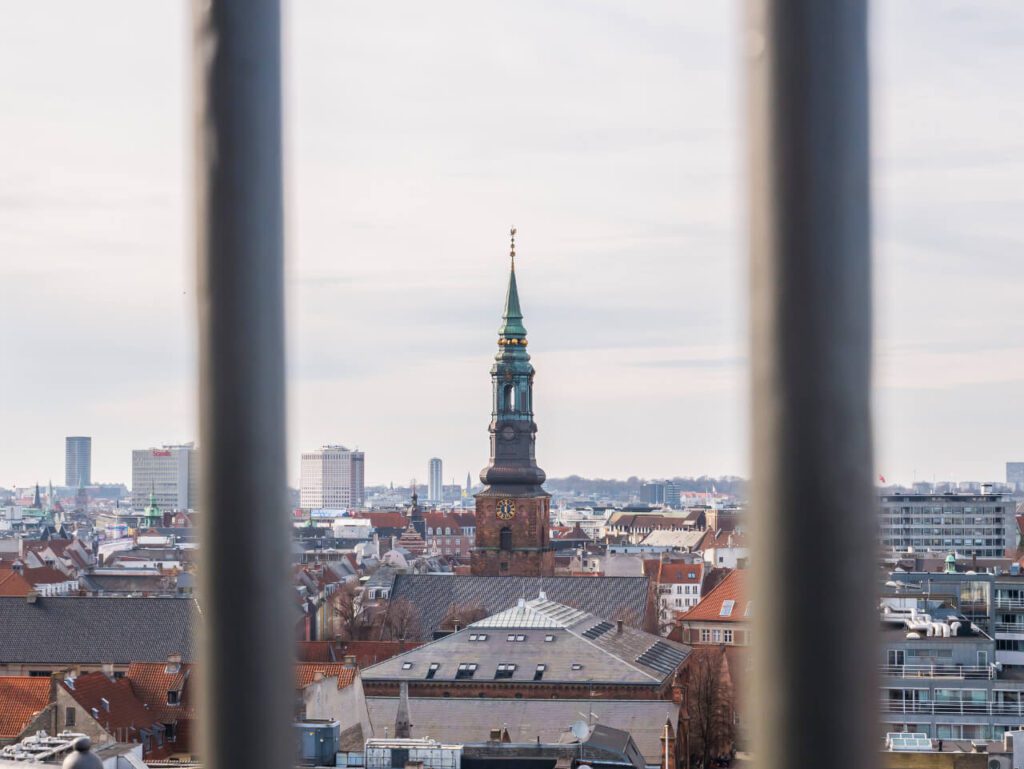

The attraction is very popular with the Danes themselves, and the tower has taken a prominent place in the national culture. The height of Danish buildings often corresponds to the size of Round Tower.
Entry with the Copenhagen Card is free.
Many cities can boast on having a representative street in the very center. Copenhagen is one of them because of Strøget Street.
This group of streets and squares is one of the longest promenades in Europe. Its length of 1.1 km is certainly less than the promenades in Bordeaux and Kaunas.

Strøget connects Kongens Nytorv Square with Town Hall Square (Rådhuspladsen). Many restaurants and shops are located next to the promenade, including points of the most prestigious global brands. The buildings are relatively young. Buildings from the end of the 19th century and the beginning of the 20th century predominate. The oldest building was built in 1616.
On Strøget Street you will find important Copenhagen churches. Church of St. Spirit (Helligåndskirken) with the House of the Holy Ghost is the oldest fully preserved medieval building in Copenhagen. The Lutheran Cathedral of the Virgin Mary (Vor Frue Kirke) was the former coronation church of the Danish monarchy.

Strøget is also one of the first streets in Europe completely closed to car traffic. The doom day for the Copenhagen cars came on November 11, 1962, when the idea of Alfred Wassard was implemented. He wanted the city to focus more on the comfort of pedestrians and cyclists.
It was then that the Danish revolution began. After several decades, it made Copenhagen one of the world’s friendliest and most comfortable cities.
Initially, Wassard’s idea did not appeal to the drivers very much. He even received criminal threats from them. Fortunately, that was it.
While strolling around Strøget, it is worth going to the Town Hall Square and the city hall. Inside city hall you will find Jens Olsen’s World Clock – an extremely complicated and advanced, historic astronomical clock.
Strøget is of course free to stroll through, although the promenade is full of places to spend money.
EXPLORE COPENHAGEN CONVENIENTLY
Do you want to save time? Get a map of the most important points of Copenhagen – worth visiting places, monuments, the best cafes, restaurants, museums and recommended accommodation.
Works both on phone & computer (Google Maps).
A small piece of land on the former military base in Copenhagen’s Christianshavn district became the scene of an extremely interesting social experiment in 1971.
Journalist Jacob Ludvigsen described Christiania’s mission. He described it as a willingness to create a self-determining, economically independent community where each member would be responsible for its common good. Ludvigsen’s appeal was enthusiastically received among anarchist circles, which began to illegally settle in abandoned buildings.
The district developed in an exemplary fashion. Small schools and kindergartens were established for the local community. The raw, post-military walls of the barracks gained new life, and artists found a place to devote themselves to art.
The settlers did not mind the unclear legal status of the area and the risk that they would have to leave the district one day. It never happened, but other devastating plagues struck Christiania.

By the end of the 1980s, the neighbourhood was becoming more and more dominated by gangs who made their fortunes from drug trafficking and prostitution. Christiania’s main street, Pusher Street, was filled with dealers who offered hard drugs forbidden by Christiania’s internal laws.
The district community introduced, partly due to the mafia, e.g. no use or possession of weapons, no bulletproof vests, no photography or no … running.
Why was running in the eyes of the community a bad thing?
Nobody thought about people doing sports. It was assumed that it is either to run away or to chase someone if you run. Therefore, the runners were treated as policemen and thieves – and both of these groups in Christiania were unwelcome. During the police raids on drug dealers, the inhabitants of the district were killed uninvolved in the practice, so life here became more and more difficult.
Today, Christiania is inhabited by less than 1,000 settlers, although initially there were several times more. After Danish courts granted residents the right to live in the district and then taxed them, the squat nature of this free city has lost much of its relevance.
Christiania is heavily commercializing. There are many souvenir shops and restaurants for tourists here, with the most famous Cafe Nemoland at the forefront. The idea of a self-determined community with its own rights lost its importance.
However, the community is still very closely connected with this place and defends it in every, even the smallest moment of danger. When the city authorities demolished one of the abandoned, ruined buildings in May 2007, the inhabitants of Christiania started a riot that the police had to suppress with tear gas. Ultimately, the demolition affected only one building – no one dared to do more.
Even though Christiania changes to a side inconsistent with the idea of its founders, this district is worth visiting. During the day (and probably also at night) it is just as safe here as in other parts of Copenhagen. In the atmosphere of relaxation and lack of rush, you will enjoy the eyes with buildings decorated with graffiti, dozens of colorful bicycles and … stalls with marijuana and hash.
The lack of photos from Christiania is intentional. The residents do not wish to have their neighborhoods photographed. I did not want to break this rule.
The gate of Christiania is only a few steps away from the tallest temple in Copenhagen – the Church of Our Saviour.
The first thing you will notice is the 90-meter high tower. There is a spiral staircase leading up to the figure of Christ the Redeemer outside.

As in the case of many significant buildings in the Danish capital, King Christian IV was the initiator of the church’s construction. However, during his reign, the characteristic tower was not built yet. The temple gained it only after 50 years. The interior of the church is magnificent. Inside the church, you will see the main altar from the beginning of the 18th century. You can also look at the organ from 1698, which again fulfils their basic function after renovation in the 20th century.
There are 400 steps to the top of the church. 150 of them are outside the building. The tower appears in the story of Jules Verne’s Journey to the Center of the Earth. It was here that the heroes got used to the fear of heights.
Residents of the city decided in a public vote that the view from the tower of the Church of Our Savior is the best view of Copenhagen.
In 1847, Jacob Christian Jacobsen opened a brewery in Copenhagen. Today is known worldwide under the Carlsberg brand.
Unfortunately, the Carlsberg Museum closed in December 2018 due to deep modernization. Follow the brewery’s website for information about the reopening of the place.
Unfortunately, the Elephant Gate was also renovated during my stay in Copenhagen. May you have more luck with this part of the city.
See all available hotels & hostels in Copenhagen
Where to stay in Copenhagen?
LOW-BUDGET
FEATURES
clean, spacious dormitories
close to public transport
CONVENIENT
FEATURES
high standard
further from the center
close to metro
If it turns out that you have a little more time to explore Copenhagen, I recommend checking out a few more interesting attractions. Lovers of art, architecture and nature will find something for themselves here.
National Gallery of Denmark is an art museum with a collection of nearly 9,000 paintings and 300,000 works of art on paper. Many of the works come from the collections of Danish kings. The oldest paintings come from the 12th century. A must-see for those interested in painting or Danish decorative art in general.
An art museum with a collection of nearly 9,000 paintings and 300,000 works of art on paper. Many of the works come from the collections of Danish kings. The oldest paintings come from the 12th century. A must-see for those interested in painting or Danish art in general.
The most important Danish museum, located in a prince’s palace from the 18th century. In that place, you will learn the history of the Danish nation from the Wigings to the present day. The museum’s collections come from different epochs. It belongs to various fields of history and science – archaeology, numismatics, ethnology, natural history.
EXCHANGE CURRENCIES CHEAPER
Exchange in exchange offices is expensive and inconvenient.
I use the Curve card and exchange currencies at the cheapest possible interbank rate. Using the card is free, and you will receive a bonus after first transaction.
The Frederik’s Church, also known as the Marble Church, has the largest dome in Scandinavia. The building was modelled on the Papal Basilica of Saint Peter in the Vatican. Built for over 100 years, the temple is now a Lutheran church.
North Atlantic House is a cultural center, located in a former industrial building. It is picturesquely situated on the shores of one of Copenhagen’s canals. A must-see for those looking for exhibitions, performances and any cultural activities.
The second most popular (after Tivoli Park) amusement park in Denmark. Bakken Amusement Park is located outside the center of Copenhagen. It was opened in 1583 and is the longest-running amusement park globally. The attractions cover as much as 75 hectares – so it’s hard to get bored. If you are a fan of French impressionists art, you can visit The Ordrupgaard Collection in the neighbourhood as well. Bakken Amusement Park is also close to Deer Park (Jægersborg Dyrehave).
A huge complex of aquariums is enclosed in a modern, silver block of a building located on the shores of the Baltic Sea. It is the largest aquarium of this type in Northern Europe. An excellent opportunity to admire water creatures from around the world.
In the neighbourhood of the Tivoli Gardens, you can also visit the Copenhagen Zoo. It is home to over 4,000 species of animals from different parts of the world. It will be an interesting attraction, especially for children.
Copenhagen’s attractions are enough for a few days of active sightseeing, but at some point, you may feel like jumping out of the city for a while. In the neighbourhood of the Danish capital, you will find some interesting attractions that are worth including in your itinerary.
Roskilde Cathedral is a 12th-century church that is the first Gothic temple in all of Scandinavia. The Roskilde Cathedral is included on the UNESCO World Heritage List since 1995. This place is important to Danish history – it is the burial place of as many as 39 Danish kings and queens. The oldest grave is Harald Blue Tooth, which ruled Denmark in the 10th century.
Kronborg Castle is a building beautifully situated on the Øresund Strait located in the city of Helsingør. Like the Roskilde Cathedral, the building is on the UNESCO World Heritage List. It was added to it in 2000.
The castle was a symbol of Danish power and lordship over the Øresund. He appears in Shakespeare’s Hamlet under the name Elsinore (referring to the town’s name in where it is located). The interior of the castle is famous for being the longest hall in Europe, 62 meters long.
Frederiksborg Castle is today the seat of the National Historical Museum, and originally – the historic royal residence. The castle is located in the town of Hillerød. It was built in the 16th century.
Many royal coronations and weddings took place in this place. The picturesque surroundings of the castle and its location by Lake Slotssøen make this place a popular destination among tourists.
EXPLORE COPENHAGEN CONVENIENTLY
Do you want to save time? Get a map of the most important points of Copenhagen – worth visiting places, monuments, the best cafes, restaurants, museums and recommended accommodation.
Works both on phone & computer (Google Maps).
If you plan to enter at least several museums or ticketed attractions, it is worth buying the Copenhagen Card.
The Copenhagen Card includes more than 80 attractions, including a city canal cruise from Nyhavn, museums’ admission, and palaces’ visits.
You can check the available versions of the Copenhagen Card and their prices on the website. You can easily buy the card online.
With the card, you can travel for free by metro, trains and buses in the Greater Copenhagen area (zones 1 to 99). Fortunately, most of the sights are in the center of Copenhagen so you can reach them on foot.
The card is not valid on trains going to Malmö, Sweden.
The city’s location next to the Swedish border meant that the capital of Denmark is served by two airports – in Copenhagen and Swedish Malmö.
The airport in Copenhagen is well connected to the city centre. The journey takes only 15 minutes. We can choose the metro, train and bus. Driving by bus, however, will be significantly longer. Copenhagen is divided into three ticket zones for public transport.
If you have a Copenhagen Card, travelling by all types of public transport is free. It is worth taking care of the Copenhagen Card at the airport.
The airport metro station is located above Terminal 3. You can buy metro tickets directly at the station. Luckily, all trains depart in one direction – to Vanløse station. If you want to get to the center, get off at Kongens Nytorv (close to the Nyhavn canal) or Nørreport.
Like the metro, trains depart from around Terminal 3. There is a free shuttle bus between Terminals 1 and 3. Trains run to Copenhagen Central Station in less than 15 minutes. You can buy tickets at the metro station.

The route from the airport to the city centre is taken by bus line 5A. The journey to Copenhagen’s main train station is twice as long as a journey by train. Like all other means of transport, buses depart from outside Terminal 3.
You can buy tickets from ticket machines or directly from the driver. The driver accepts payment only in coins (he does not accept banknotes).
Copenhagen has, of course, a wide range of accommodation, but accommodation prices are very high. However, you can find comfortable facilities at acceptable prices.
The closer your accommodation is to the city centre, the less time and money you will spend travelling to attractions. Take this into account when booking your accommodation.
LOW-BUDGET
FEATURES
clean, spacious dormitories
close to public transport
PET FRIENDLY
FEATURES
close to train station
organizes e.g. bike tours
CONVENIENT
FEATURES
high standard
further from the center
close to metro


I hope my suggestions for must-see places and attractions worth seeing in Copenhagen will help you plan your visit to Denmark’s capital. As you can see, the magical city of Copenhagen is much more than Hans Christian Andersen fairy tales and its top attractions. The city is filled with beautiful gardens, interactive exhibits and cultural spots. It has many hidden gems that are definitely worth seeing. Have a good trip and have a good time in wonderful Copenhagen!
EXPLORE COPENHAGEN CONVENIENTLY
Do you want to save time? Get a map of the most important points of Copenhagen – worth visiting places, monuments, the best cafes, restaurants, museums and recommended accommodation.
Works both on phone & computer (Google Maps).
Welcome to my travel blog!

Hi! I’m Bartek Dziwak – traveller & travel blogger with 10 years of travel experience.
Feel free to use a tons of information from this blog to make your travel better.
Practical Tips
Book your stay: check out hotels and hostels in a good location and book your stay before others take your place.
Exchange money cheaper: order a free Curve card to exchange money cheaper than in an exchange office and get £10 as a gift
Check My Travel Shop: check ready-made hiking routes and city attractions maps that will make your sightseeing easier.
Is my article helpful?
Help me keep making these travel articles for you by supporting me with a cup of coffee.
Check My Ebooks
Polish Mountains - MAP of Mountain Ranges & Peaks & Accommodation
BIAŁOWIEŻA NATIONAL PARK – MAP of 50+ Best Places to See
MAZURY & WARMIA (LAKES DISTRICT) – MAP of 200+ Best Places to See
Mountains of Lower Silesia (Poland) - 55 Best Hiking Routes
Prepare to Travel Abroad – Practical Tips
Exchange money cheaper: order a free Curve card to exchange money cheaper than in an exchange office and get £10 as a gift.
Book accommodation that suits you: check out hotels, hostels & apartments in a good location and book your stay before others take it.
Check My Travel Shop: check my ebooks with maps of cities & regions attractions and ready-made hiking routes that will make your sightseeing easier.
Is my article helpful to you? Help me keep making these travel articles for you by supporting me with a cup of coffee. I really love Aeropress!

Hi from the author! I’m Bartek Dziwak – traveller and founder of BartekOnTheGo.com travel blog.
I inspire people to travel around the world on their own and discover both famous and unusual places.
Check My Ebooks



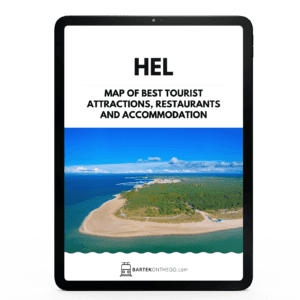

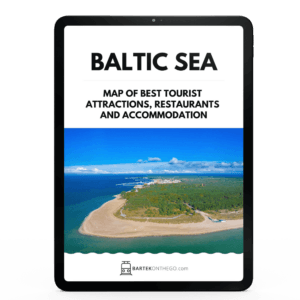
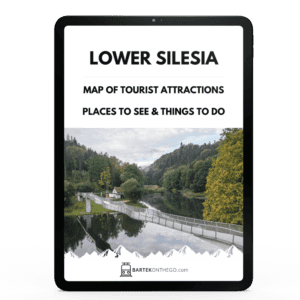





| Cookie | Duration | Description |
|---|---|---|
| cookielawinfo-checkbox-analytics | 11 months | This cookie is set by GDPR Cookie Consent plugin. The cookie is used to store the user consent for the cookies in the category "Analytics". |
| cookielawinfo-checkbox-functional | 11 months | The cookie is set by GDPR cookie consent to record the user consent for the cookies in the category "Functional". |
| cookielawinfo-checkbox-necessary | 11 months | This cookie is set by GDPR Cookie Consent plugin. The cookies is used to store the user consent for the cookies in the category "Necessary". |
| cookielawinfo-checkbox-others | 11 months | This cookie is set by GDPR Cookie Consent plugin. The cookie is used to store the user consent for the cookies in the category "Other. |
| cookielawinfo-checkbox-performance | 11 months | This cookie is set by GDPR Cookie Consent plugin. The cookie is used to store the user consent for the cookies in the category "Performance". |
| viewed_cookie_policy | 11 months | The cookie is set by the GDPR Cookie Consent plugin and is used to store whether or not user has consented to the use of cookies. It does not store any personal data. |